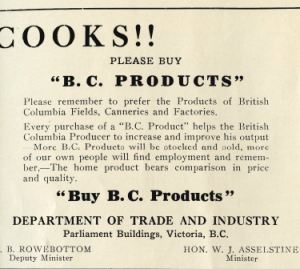Buy Local – “Buy BC”, “Buy Canadian”
In the midst of the COVID-19 pandemic, we are reminded by our provincial government to support local restaurants, farmers, and food producers, arguing that Buy BC is important for the economic and social well being of individuals and the country.[i]
Additionally, the federal government, worried about consumers becoming increasingly disconnected from how their food is produced, is getting ready to roll out a five-year, multimillion-dollar ad campaign this coming summer to “Buy Canadian”. By teaching the public how Canadian farms operate and what their standards are, it is hoped that Canadian consumers will change their buying habits and support local economies.[ii]
Such campaigns are not new. The first “Buy Canadian” can be traced back to at least 1914 when the First World War economy saw imported products as a threat.[iii]
Versions of “Buy BC” have been around since the early 1900s. The BC Women’s Institute lists starting the first Buy BC campaign in the 1930’s among their accomplishments.[iv]
In the 1930s, the community of Oliver had the first B.C. products week to encouraged people to buy B.C. products and counteract the push from Washington State to buy that state’s produce[v].
The October 11, 1939 Vancouver Province headline read: Board Of Trade Urges B.C. Goods For Public Contracts. Bruce A. McKelvie, who was manager of the Vancouver Board of Trade Manufacturers’ Bureau, is credited with launching a successful “Buy B.C. Products” campaign[vi].
In June 1941 at a meeting held in Salmon Arm, D. M. Rattray, president of the B.C. Fruit Growers Association, “hinted broadly that the federal government might help by restricting importation of foreign fruits and vegetables during the time of stress….also suggest[ing] that Coast folk might well take their own action by waiting for and giving preference to the products of their own province.”[vii]
The following appeared in a Second World War Cookbook created by the Victoria chapter of the International Order of Daughters of the Empire in 1941:[viii]
This iconic logo, familiar to most British Columbians, was launched in 1993.
It indicated partnership between the provincial agriculture department and industry (farmers, processors, manufacturers and retailers), with the objective of building consumer awareness, loyalty and demand for British Columbia’s agrifood products. Bill Barlee, an NDP MLA elected in 1988, developed and championed the program. When the NDP formed the BC government, he was appointed Minister of Agriculture, Fisheries and Food from 1991 to 1993. His plan involved a five-year commitment of $9.5 million, with $1.5 million allocated for the first year to be used in both direct marketing and conventional food marketing channels[ix].
The Buy BC program was canceled by the provincial Liberal government in 2001. At that time 1,200 companies and associations were using the “Buy BC “logo in their advertising and promotional materials and over 5,000 Buy BC products identified at major grocery retailers throughout the province. Research at the time showed that recognition of the Buy BC logo was at 76 percent, compared to just 27 percent in 1998.[x] A 1996 review of the program estimated that the program had helped generate 1900 jobs in the agri-food sector over a three-year period. After funding for Buy BC was cancelled, the Province licensed the rights to the Buy BC brand to the B.C. Agriculture Council (BCAC). Without provincial funding for business participation and marketing, BCAC struggled to continue the program.[xi]
Buy BC was re-launched in 2018 by the NDP government in an effort to fuel public interest in shopping for made-in-B.C. products.[xii] Lana Popham, who had been Opposition critic for agriculture for eight years before becoming Minister of Agriculture for the current government, engineered the re-launch and expansion of the program to “Grow, Feed and Buy BC”. Cost-shared funding is available to applicants to undertake sector/product specific marketing and promotional activities to increase consumer demand and sales of BC agrifood and seafood products within the Province (more details on the Buy BC website).[xiii]
Campaigns such as Buy BC encourage consumers to include the provenance of their food in their purchasing decisions and are significant factors in establishing and developing an identity for local products.
These approaches are described as place-based product identification schemes. They are driven by a strong territorial development rationale; they are not quality-based programs per se[xiv]. Place-based marketing strategies are effective because they highlight and invite identification with the social embeddedness of the product, and take advantage of the powerful links among food, place and values of food producers who are rooted in place of food origins.[xv]
The problem with government initiated promotions is that they are vulnerable to changes in political priorities and thus to a possible shift in government funds to other activities or even cancellation (especially with a change of government). The scope and longevity of the campaign is important in contributing to an increase in consumer demand for local food.[xvi]
It’s possible once our appetite for local foods[xvii] has been established, the momentum will continue with or without government support. We can always “vote with our fork” at the market and grocery stores and at election time.
Endnotes:
[i] https://buybc.gov.bc.ca/learn-about-bc-food/support-local/
[ii] https://globalnews.ca/news/6435463/buy-canadian-promotional-campaign/
[iii] https://www.tradeready.ca/2016/trade-takeaways/face-off-buy-local-vs-buy-global/
[iv] https://www.bcwi.ca/about
[v] https://archive.news.gov.bc.ca/releases/news_releases_2005-2009/2009al0004-000456-attachment1.htm
[vi] https://search-bcarchives.royalbcmuseum.bc.ca/Document/Finding_Aids_Atom/MS-0001_to_MS-0500/ms-0001.pdf
[vii] http://www.vancouverhistory.ca/biz_1940.htm
[viii] IODE, (1941). Victory Cook Book. Wartime Canada http://wartimecanada.ca/document/world-war-ii/recipes/victory-cook-book
[ix] Rice, G. (2008). The Lower Mainland Food System: The Role of Fruit and Vegetable Processing. Masters Thesis, Royal Roads University, Victoria, BC.
[x] Ilbery, B., Morris, C., Buller, H., Maye, D., & Kneafsey, M. (2005). Product, process and place: an examination of food marketing and labelling schemes in Europe and North America. European Urban and Regional Studies, 12(2), 116-132; http://bcndpcaucus.ca/news/flip-flop-on-buy-b-c-program-evidence-of-b-c-liberal-mismanagement/; Ference Weicker & Company Ltd. (n.d.). Branding BC Agriculture and Food Production. Vancouver: Ference Weicker & Company Ltd.
[xi] Dell, W. M. (2009). Pathways to Resilience: Obstacles and Opportunities for Small-Scale Agriculture and Local Food Systems in British Columbia. Masters Thesis, University of Victoria; Rice, G. (2008). The Lower Mainland Food System: The Role of Fruit and Vegetable Processing. Masters Thesis, Royal Roads University, Victoria, BC.
[xii] https://www.cbc.ca/news/canada/british-columbia/buy-b-c-is-back-to-boost-made-in-province-products-1.4720779 ;
https://www.cheknews.ca/province-relaunches-buy-bc-to-help-promote-local-products-463672/;
[xiii] http://iafbc.ca/buy-bc/logo-licensing/; buybc.gov.bc.ca
[xiv] Ilbery, B., Morris, C., Buller, H., Maye, D., & Kneafsey, M. (2005). Product, process and place: an examination of food marketing and labelling schemes in Europe and North America. European Urban and Regional Studies, 12(2), 116-132.
[xv] Elliott, C. (2016). How Canadians Communicate VI: Food Promotion, Consumption, and Controversy. Athabasca University Press, p. 32.
[xvi] Wittman, H., Beckie, M., & Hergesheimer, C. (2012). Linking local food systems and the social economy? Future roles for farmers’ markets in Alberta and British Columbia. Rural Sociology, 77(1), 36-61.
[xvii] Edge, J. (2013). Cultivating Opportunities: Canada’s growing appetite for local food. The Conference Board of Canada.


